Montevideo Travel Guide
Located on the north shore of the Rio de la Plata, Uruguay's vibrant, eclectic capital blends Old World charm with latter-day style in an unforgettable way. Visitors will discover a laidback destination of glorious beaches, leafy plazas, colourful buildings and splendid colonial structures, where adventure awaits.
A trip to Montevideo's Ciudad Vieja (Old Town) makes an excellent opening chapter to a stay in the capital. An elegant district of narrow cobblestoned streets and colonial buildings, it's home to both Spanish and Portuguese influences, and its fascinating museums are well worth visiting. The city's beautiful beaches, cosy tango bars, elegant old theatres and countless pavement cafes provide delightful changes of pace and, as Uruguay is renowned for the quality of its beef, foodies must eat at one of Montevideo's barbeque restaurants.
Things to do in Montevideo
Culturally rich and home to nearly half of Uruguay's population, Montevideo is easily as captivating as South America's more famous capitals. Travellers often begin their stays with a visit to the city's gorgeous beachfront, whether they wish to windsurf, jog round the breezy ramblas (esplanades) or simply relax with their families. Ciudad Vieja (Old Town) is a must for its historic architecture and museums, and Plaza Independencia is full of photographable landmarks. Tango bars, theatres, the frenetic football stadium, Estadio Centenario, and a choice selection of excursions should also be high on travellers' lists of priorities. Foodies, however hard to please, will enjoy the destination's world-class beef, as well as its close proximity the most important wine region in Uruguay.
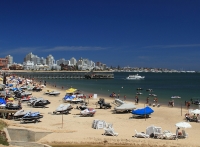
Punta del Este
Often called the 'Hamptons of South America', Punta del Este holiday resort is a favourite destination among wealthy Argentines and Uruguayans. Located on Uruguay's southern tip, its pristine, sandy beaches, yacht marinas, luxury hotels and holiday condominiums scream money. Thousands of moneyed visitors arrive during the summer holiday season, when sophisticated shops, clubs and restaurants do most of their business. The off-season sees many of Punta del Este's establishments close, transforming the area into something like a sleepy coastal town.
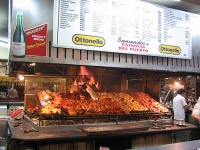
Mercado del Puerto (Port Market)
Set under a vast, cast-iron structure reminiscent of old European railway stations, Montevideo's Mercado del Puerto (Port Market) is a lively affair. A hive of trading activity since 1868, the area no longer operates as a market, instead housing some of the finest seafood eateries in the city and perhaps the best steakhouses in South America. Visitors should try the traditional drink called medio y medio (champagne mixed with white wine) with their meals, and linger to watch the city's talented buskers and entertainers.
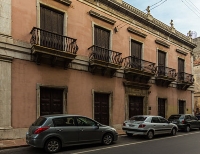
National History Museum
The Museo Historico Nacional is a treat for visiting history buffs. Located in the Old City, it's made up of old houses where prominent historical figures once lived, and its collection traces the history of Uruguay from before European colonisation to the mid-20th century. Exhibits include books, documents, furniture, photographs and works of art. The houses that make up the museum are Casa de Antonio Montero, Casa de Juan Antonio Lavalleja, House of Manuel Ximénez and Gomez, House of Joseph Garibaldi, Casa de Juan Francisco Giró, House fifth of Luis Alberto de Herrera and the fifth house of José Batlle y Ordóñez.
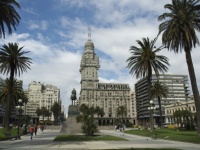
Plaza Independencia
Montevideo's showpiece plaza contains some of the city's most impressive architecture, including its best-known landmark, the Palacio Salvo. Designed by Italian architect, Mario Palanti, and completed between 1927 and 1928, it was originally intended as a hotel but instead came to house an elaborate collection of offices and residential apartments. It was once the tallest building in South America and was built on the site where Gerardo Matos Rodriguez wrote La Cumparsita: one of the most famous and recognisable tangos of all time. The Plaza also contains a statue of Uruguay's national hero, General Artigas.
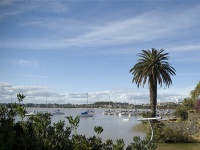
Colonia del Sacramento
The historic town of Colonia del Sacramento is a must-see for anyone visiting Uruguay. Situated on the River Plate, this celebrated UNESCO World Heritage Site is the oldest settlement in the country and welcomes many ferry visitors from Buenos Aires on the other side of the river. The quaint town was founded in 1680 and is home to cobbled streets and brightly coloured houses, vibrant bars, excellent restaurants, and a wonderful array of art and craft shops. Colonia is about a two-hour drive from Montevideo.
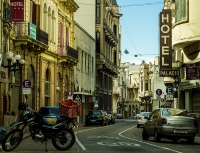
Ciudad Vieja
Montevideo's old city is a vibrant, fascinating district of grand historic buildings and cobbled streets. Weekends see dancers and musicians gather for impromptu performances, and artists have turned many of the decaying, ground-floor apartments into studios and galleries, where visitors can purchase works from some of Uruguay's finest. The area's iron gates and street lamps are very photogenic. Travellers are sure to find a wonderful juxtaposition of old and new, making Ciudad Vieja the purest embodiment of Montevideo's evolution.
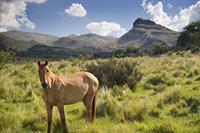
Estancias
Estancias (ranch houses) and the gaucho (cowboy) lifestyle they preserve are integral to Uruguay's identity. Guests can enjoy fishing, tannery visits, stargazing, bonfires and horse-riding excursions across the country's pampas (grasslands), and will come away with an intimate connection to Uruguay's culture. Options range from basic ranch houses, where visitors breakfast on galleta de campana (a type of biscuit that lasts for a week), to establishments with pools, saunas and libraries. Guests will also of have many opportunities to try Uruguay's famous asado (barbeque).

Estadio Centenario
Built between 1929 and 1930, the Estadio Centenario commemorates the centenary of Uruguay's first constitution, and hosted the first-ever FIFA World Cup final, in which Uruguay beat Argentina by four goals to two. Listed by FIFA as one of the world's Classic Stadiums, the Estadio Centenario has become a bucket-list item for many football fans. Thousands of tourists visit every year, either to attend a match or to enjoy the fascinating Museo del Fútbol (Football Museum) housed within the stadium itself.
Getting Around
Buses run all over the city until around 11pm daily, and are cheap and easy to use. Visitors can buy tickets directly from the driver or conductor, who can also offer advice on routes and destinations. Taxis are metered and plentiful.
Otherwise, locals are generally friendly and willing to point travellers to various sights and attractions. A Spanish phrase book is useful for this reason.
Montevideo Climate and Weather
Montevideo's climate is mild, with an average annual temperature of around 55°F (13°C). During the height of summer (January), Montevideo's average temperatures range from 64°F (18°C) to 82°F (28°C), while winters (June to August) are much cooler and tend to be wet. Average temperatures range between 45°F (7°C) and 53°F (12°C). Autumn is the wettest season.
Given its temperate climate, Montevideo is a pleasant destination at any time of year, though summer and early spring are probably the best times to go.
Uruguay travel info
Electricity
T electrical current is 230 volts, 50Hz. There are various types of plugs in use, including ‘Schuko’ plugs, and the plugs commonly used in Australia.
Language
The official language is Spanish.
Money
The official currency of Uruguay is the Uruguayan peso (UYU) but some tourist businesses, retailers and taxi drivers also accept US dollars. The peso is divided into 100 centésimos and currency can be exchanged at banks and Money Exchange Shops, which offer similar exchange rates. ATMs are widespread in all but the smallest interior towns; most upmarket hotels, restaurants and shops accept credit cards.
Tipping
Tipping is discretionary in Uruguay but a gratuity of between five and 10 percent of the bill is usually offered in restaurants. Passengers usually round up the bill for taxi drivers; guests ordinarily tip hotel porters about $1 per bag.
Health
Hepatitis A and hepatitis B vaccinations are recommended, and travellers are advised to take precautions against mosquito bites due to a high risk of dengue fever. Medical and dental treatment is expensive in Uruguay so comprehensive travel health insurance is strongly recommended. It's best to take sensible precautions regarding the consumption of food and water; visitors should stick to washed, peeled and well-cooked food, and bottled or purified water are better options than tap or well water.
Safety
Though visits to Uruguay are generally trouble free, street crime such as bag snatching, pick-pocketing and mugging does occur in Montevideo. Visitors should take care when withdrawing money from ATMs, and avoid carrying large amounts of cash or wearing expensive jewellery. The risk of terrorism is low.
Local customs
Uruguay is a secular and progressive country where gay and lesbian visitors are most welcome. Indeed, Uruguay is widely considered the most LGBT-friendly destination in South America. Locals tend to stand close together when talking and it's considered rude to back away. Close acquaintances may greet with a kiss on the cheek, though a handshake is perfectly all right for introductions.
While gender equality is progressive in Uruguay, women may experience a fair amount of attention that can border on harassment at times. Visitors should avoid making critical comments about the country, or comparing it to Chile, Argentina, and Paraguay.
Doing business
Uruguayans appreciate those who dress well, so a conservative yet stylish outfit will go a long way towards making a good first impression. Dark-coloured suits and light shirts are good options for men, while women should stick to business suits or elegant dresses.
Titles are important and it's best to address people by professional honorifics such as doctor where applicable. There is no specific ritual surrounding the exchanging of business cards, though it's courteous for foreigners to have one side translated into Spanish. Most businessmen speak English but it's good to suggest hiring of an interpreter as a sign of consideration. Foreigners should avoid hard selling and any sort of confrontation wherever possible, as locals respond far better to the soft sell.
Duty free
Visitors to Uruguay do not need to pay customs duty on four cartons of cigarettes, 6 litres of distilled alcoholic beverages, 5kg of foodstuffs and goods up to US$500 if bought at the entry duty free shops. Certain foodstuffs, plants, narcotics, pornographic material and explosives are strictly prohibited. Live animals, endangered species, medication and large sums of money are restricted. Visitors should check with official government sources before bringing such items in to the country.
Communications
The international dialling code for Uruguay is +598. Visitors can purchase local SIM cards with reasonably priced data plans for unlocked phones; WiFi is widely available in cities and larger towns.
Passport & Visa
All visitors to Uruguay must hold an onward or return ticket and documents for their next destination. It is highly recommended that passports have at least six months' validity remaining after the intended date of departure. Immigration officials often apply different rules to those stated by travel agents and official sources.
Entry requirements
US citizens require a valid passport, but a visa is not required for a stay of up to three months.
All British nationals require a valid passport for travel to Uruguay. A visa is not required for a stay of up to three months for all British passport holders.
Canadians require a valid passport, but no visa is required for a stay of up to three months.
Australians require a valid passport, but a visa is not required for a stay of up to three months.
South Africans require a valid passport, but a visa is not required for a stay of up to three months.
Irish nationals require a valid passport, but a visa is not required for a stay of up to three months.
New Zealand nationals require a valid passport, but no visa is required for a stay of up to three months.



